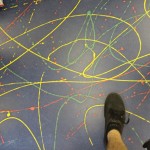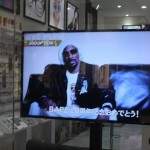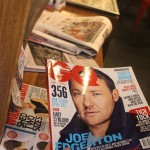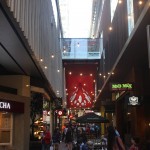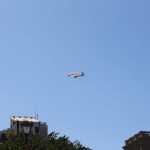One hour down in our media lectorial (it’s a word) and we are sent forth from the depths of our dimlit den to prey upon the world. Like Mr. Burns releasing the hounds our teaching staff decided to unleash roughly a hundred admitted clue-less students into the unprepared media ridden world. To lighten the blow we were separated into groups, in an attempt to cover as much area as possible. Our battalion (group 2) was assigned the Queen Victoria Building with the objectives of gaining entry and taking note of every source of media they were armed with.
Without a moment to lose we shuffled out from behind our desks, checked once, twice, three times that we were the right group and staggered out of the RMIT building not sure who was leading the way and who we were waiting for. We took a sharp turn south, narrowly avoiding Colonel Sanders’ signboard and brushing away progressive propaganda posters with hand singles reminiscent of the original Karate Kid. This job was going to be much harder than we thought with socialists and self-promoting sou chefs outflanking us.
Our every move caught on video from the overhead security cameras we stumbled over graffiti and discarded food packaging barely catching a glimpse of the happy green man before he transformed into a flashing red symbol of rejection. The few behind us weren’t so lucky, including the suited man chatting with his handsfree and the schoolgirl identifiable by her blazer emblem. This media was everywhere and it showed no sign of slowing down, from the digitalised welcome sign at Melbourne Central to the relentless advertising on the skating rhinoceros.
It was becoming claustrophobic, printed media everywhere telling me not to smoke, not to litter, not to put my feet up and to keep a keen eye for cyclists in the area. Luckily I was able to find salvation in the street-art of one man, knelt down, brushing the grey pavement with a coloured bundle of horse-hair. Spirits were once again high as we arrived at our destination, stopping to discuss the journey we found we could already have enough inside information to fill one double-sided page of A4 paper divided under subheadings such as “up high” and “in your hand” – perfect because that’s just the inventory we had.
Inside QVB the media were waiting to ambush us, they’d conscripted an army comprised of all mediums. The air-cover was provided by banners and billboards bombarding us with logos and images of attractive youths in clothing. From the left came a wave of interchangeable motorised screens, juice-bar menus that rolled to the frontline special after special after terms and conditions after specials. At the same time bringing up the rear were radio waves of top 40 hits, catchy jingles and news updates.
In order to get through this we attempted to fit in. Tyler took out his camera to “snap some pics” of complimentary magazines, Matt recorded some customer interaction and I attempted a panorama of the media lined arcade but captured a few blurry and disembodied passers by in the process. It was amazing the amount of media we had access to in both public and private domains. This is modern life, a society littered by strategically placed screens and interactive software at your fingertips.
It was a successful mission from which we’ll take away a keen eye for noticing media in everyday life. There is quite a contrast between media in Melbourne and media in my hometown Wagga Wagga. Rural society can still be defined as modern media life with access to books, newspapers and maps but is lacking in comparison multiple streams of stimulus in such a concentrated area, and the QVB is only one of few. I’ll have to remember when visiting back home to set my watch, my phone and my laptop back twenty years.
